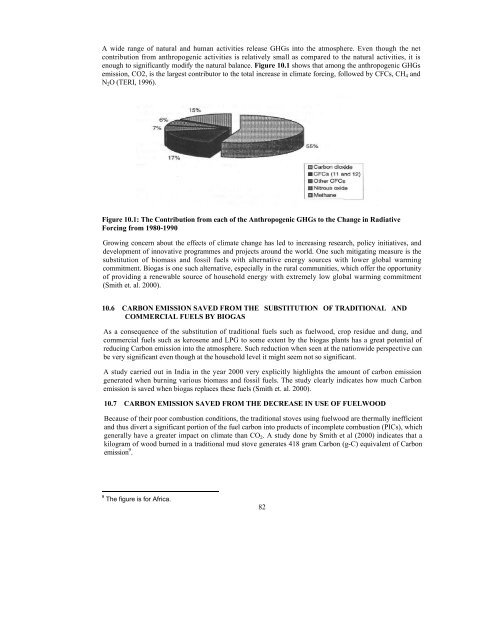download (pdf, 6MB) - SNV
download (pdf, 6MB) - SNV
download (pdf, 6MB) - SNV
You also want an ePaper? Increase the reach of your titles
YUMPU automatically turns print PDFs into web optimized ePapers that Google loves.
A wide range of natural and human activities release GHGs into the atmosphere. Even though the net<br />
contribution from anthropogenic activities is relatively small as compared to the natural activities, it is<br />
enough to significantly modify the natural balance. Figure 10.1 shows that among the anthropogenic GHGs<br />
emission, CO2, is the largest contributor to the total increase in climate forcing, followed by CFCs, CH 4 and<br />
N 2 O (TERI, 1996).<br />
Figure 10.1: The Contribution from each of the Anthropogenic GHGs to the Change in Radiative<br />
Forcing from 1980-1990<br />
Growing concern about the effects of climate change has led to increasing research, policy initiatives, and<br />
development of innovative programmes and projects around the world. One such mitigating measure is the<br />
substitution of biomass and fossil fuels with alternative energy sources with lower global warming<br />
commitment. Biogas is one such alternative, especially in the rural communities, which offer the opportunity<br />
of providing a renewable source of household energy with extremely low global warming commitment<br />
(Smith et. al. 2000).<br />
10.6 CARBON EMISSION SAVED FROM THE SUBSTITUTION OF TRADITIONAL AND<br />
COMMERCIAL FUELS BY BIOGAS<br />
As a consequence of the substitution of traditional fuels such as fuelwood, crop residue and dung, and<br />
commercial fuels such as kerosene and LPG to some extent by the biogas plants has a great potential of<br />
reducing Carbon emission into the atmosphere. Such reduction when seen at the nationwide perspective can<br />
be very significant even though at the household level it might seem not so significant.<br />
A study carried out in India in the year 2000 very explicitly highlights the amount of carbon emission<br />
generated when burning various biomass and fossil fuels. The study clearly indicates how much Carbon<br />
emission is saved when biogas replaces these fuels (Smith et. al. 2000).<br />
10.7 CARBON EMISSION SAVED FROM THE DECREASE IN USE OF FUELWOOD<br />
Because of their poor combustion conditions, the traditional stoves using fuelwood are thermally inefficient<br />
and thus divert a significant portion of the fuel carbon into products of incomplete combustion (PICs), which<br />
generally have a greater impact on climate than CO 2 . A study done by Smith et al (2000) indicates that a<br />
kilogram of wood burned in a traditional mud stove generates 418 gram Carbon (g-C) equivalent of Carbon<br />
emission 9 .<br />
9<br />
The figure is for Africa.<br />
82
















